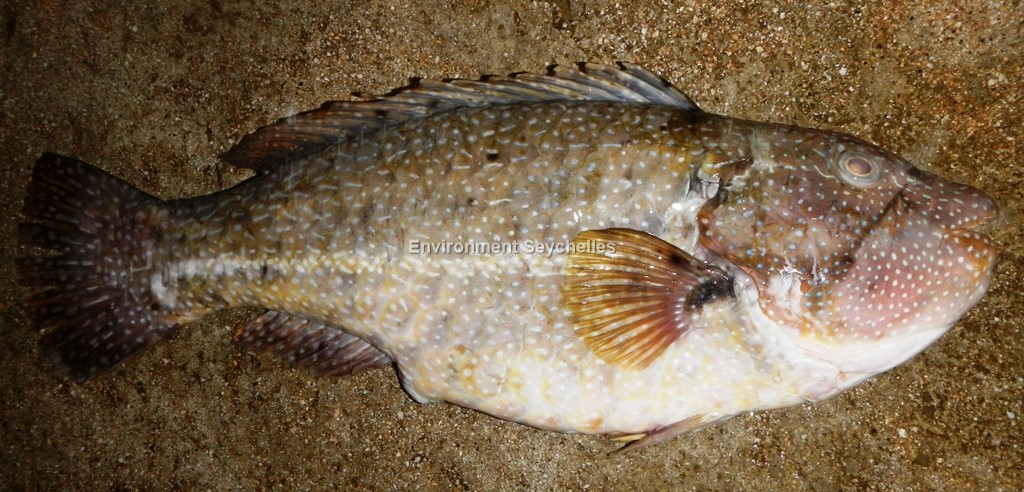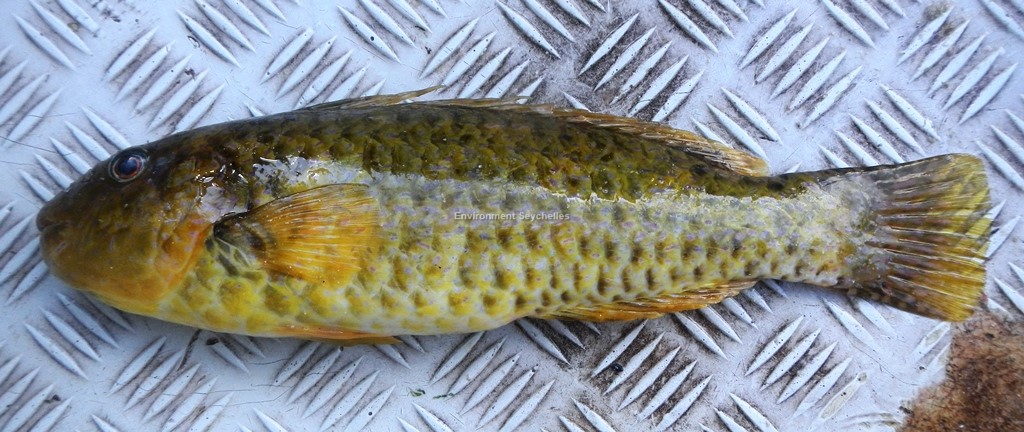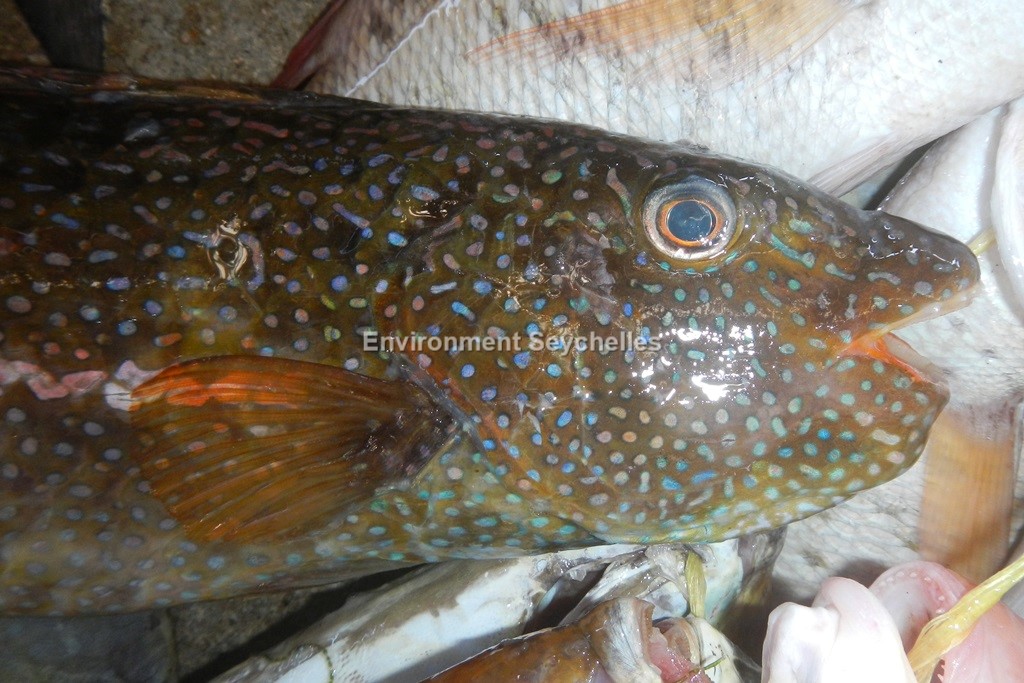Description:
Dorsal spines: 9; Dorsal rays: 10; Anal spines: 3; Anal rays: 9.
Relatively small typically slim-bodied (large male specimens can become full-bodied) parrotifsh. Blunt rounded head. Unique narrow dental plates composed
of numerous small teeth. The upper jaw teeth are enclosed by the lower when the mouth is closed. Median predorsal scales 4 (occasionally 3). Caudal fin
truncate to slightly rounded.
Colour. Body greenish with pale and dark brown scales providing marbled effect, paler below. Eye with yellow orange iris and outer green ring. Males with
small blue spots on head, body and anal and caudal fins; and a regular white stripe on body.
Size:
Maturity: Lm unknown. Range unknown. Max Length: 35 cm TL.
(Females mature at approximately 17 cm – Heemstra & Heemstra, 2004).
Habitat and Ecology:
Found in sheltered bays, harbours and lagoons with seagrass beds and shallow areas with thick algal growth (depth 1-15 m). Marbled Parrotfish usually
occur in small groups. Unlike other parrotfishes, males and females look similar and do not change sex. Larvae of this species is associated with drifting
algae. It feeds on seagrasses and algae.
Fishery Status:
This species is not protected or subject to fishery regulations. It is caught in the fish trap fishery, but is an uncommon component of the catch off the
north of Mahe where it was formerly abundant. This has been associated with extensive loss of coastal seagrass habitat to land reclamation. It still
occurs in larger numbers further south on the east and west coasts of Mahe. It is also occasionally caught in large numbers in nets.
Notes:
References:
Australian Museum (2019). Marbled parrotfish, Leptoscarus vaigiensis. https://australianmuseum.net.au/learn/animals/fishes/blue-spotted-parrotfish-leptoscarus-vaigiensis-quoy-gaimard-1824/ (19/03/19).
Bray, D. J. Leptoscarus vaigiensis in Fishes of Australia, http://fishesofaustralia.net.au/home/species/398 (19/03/19).
Choat, J.H. et al. (2012). Leptoscarus vaigiensis. The IUCN Red List 2012: http://dx.doi.org/10.2305/IUCN.UK.2012.RLTS.T190756A17777316.en. (19/03/19).
Froese, R. & D. Pauly. (Eds.) (2018). FishBase. https://www.fishbase.de/summary/Leptoscarus-vaigiensis.html (19/03/19).
Heemstra, P. & Heemstra, E. (2004). Coastal Fishes of Southern Africa. NISC SAIAB. ISBN: 1-920033-01-7.
Lieske, E. & Myers, R. (2002). Coral Reef Fishes. Indo-Pacific and Caribbean. Revised edition. Princeton University Press. ISBN 0-691-08995-7
Nevill, J. (2013). A Species Identification Guide for Commonly Caught Fish in the Seychelles Near-Shore Artisanal Fishery. GOS/UNDP/GEF.
Citation:
Nevill, J.E.G. (2019). Leptoscarus vaigiensis, Marbled parrotfish. Seychelles Seatizens. www.seatizens.sc. https://seatizens.sc/species/leptoscarus-vaigiensis-quoy-gaimard-1824/ (edited 15/08/22).




Excellent article! The depth of analysis is impressive. For those wanting more information, I recommend this link: FIND OUT MORE. Keen to see what others think!
buying from online mexican pharmacy п»їbest mexican online pharmacies buying prescription drugs in mexico online
canada pharmacy online: best rated canadian pharmacy – canada drug pharmacy
http://indiapharmast.com/# pharmacy website india
india online pharmacy online shopping pharmacy india india pharmacy mail order
canadianpharmacymeds com: legal to buy prescription drugs from canada – canadapharmacyonline com
canadian online pharmacy canadian online pharmacy reviews canadian medications
https://indiapharmast.com/# india online pharmacy
online shopping pharmacy india: top 10 online pharmacy in india – top 10 pharmacies in india
http://indiapharmast.com/# world pharmacy india
canadian pharmacy scam: legitimate canadian mail order pharmacy – reliable canadian online pharmacy
https://paxloviddelivery.pro/# paxlovid pharmacy
amoxicillin online no prescription: amoxicillin without a doctors prescription – order amoxicillin 500mg
http://paxloviddelivery.pro/# paxlovid pill
cipro online no prescription in the usa: buy cipro without rx – cipro online no prescription in the usa
https://amoxildelivery.pro/# order amoxicillin online
paxlovid buy: Paxlovid buy online – paxlovid covid
doxyciclin: doxycycline 100mg tabs – buy 40 mg doxycycline
http://doxycyclinedelivery.pro/# can you buy doxycycline over the counter
where can i buy cheap clomid without a prescription: where buy generic clomid pill – can i order generic clomid pill
https://amoxildelivery.pro/# amoxicillin 500mg capsule cost
order amoxicillin online no prescription: amoxicillin 500mg buy online uk – medicine amoxicillin 500mg
where can i get cheap clomid for sale: cheap clomid price – can i get cheap clomid online